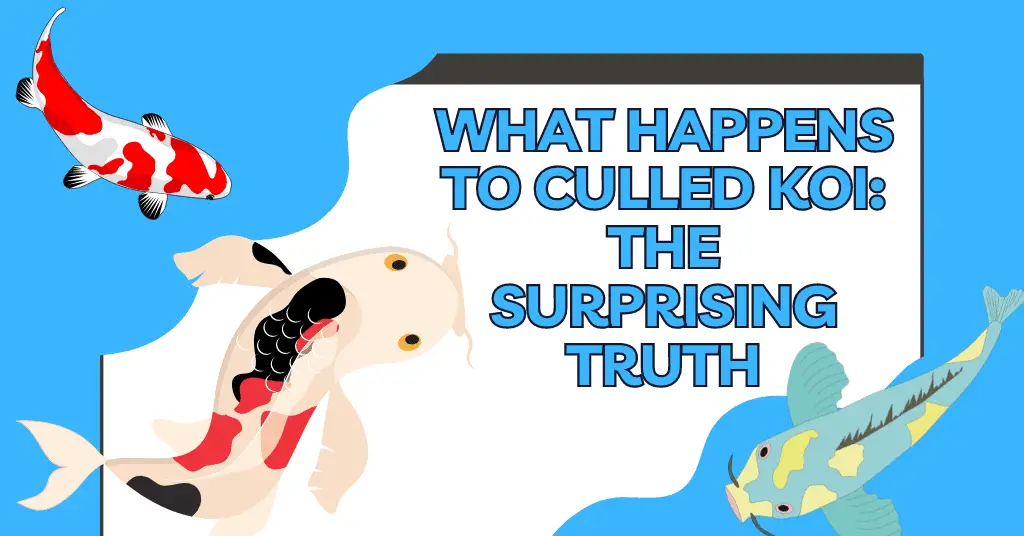Last Updated on March 29, 2022 by cmoarz
Culling is a process that is often used in the koi-keeping and breeding businesses. It is the act of removing fish from a population in order to improve the overall quality of the stock.
But what happens to those culled koi? In this post, we will explore the surprising truth about what happens to culled koi, and where they end up!

Why Culling Fish is Necessary?
Table of Contents
Culling fish is the process of removing weaker or less desirable specimens from a population in order to improve the overall quality of the group.
In many cases, culling is necessitated by genetics. For example, if a breeder wants to produce fish with a certain color pattern, they will need to remove any fish that do not display the desired traits.
Culling can also be used to improve the size or quality of a fish population. By removing smaller or less robust fish, breeders can encourage the remaining fish to grow larger and healthier.
In some cases, culling may be the only way to ensure that a fish population remains healthy and free of disease.
By carefully removing sick or weakfish, breeders can help to prevent the spread of illness and improve the overall health of the group.
For koi breeders, culling is important to remove fish that don’t meet their minimum quality standards. Poorly colored, small, or sick fish are typically the first to be culled.
Keeping these fish that will sell less, or not sell at all hurts the bottom line and takes up valuable feed and space. But don’t worry, Not all culling ends in death, at least not right away!

How are Koi Culled?
Culling is typically done by hand, using nets or seines to remove fish from ponds or tanks.
Once removed, the fish are either sent to cull farms to grow larger for feed and chum use or sold out in bulk to smaller resalers who think they can sell them.
Not all culls are equal, and there are grades of culls, from Healthy culls which are allowed to grow a full size for feed or to be resold, to genetically defunct culls which are mulched up right away.
Cull fry is also sold to retailers in bulk for resale on the market. While some of these koi might not meet the breeder’s standards, they are usually fine and pretty regardless and people do buy them.
The fish that are destined to die are often flash-frozen which is a fairly humane way to do it in large numbers. These fish are often either stored for later incorporation into various types of feed, Or used as fertilizer for crops and other uses.

Where Do They Go After Being Culled?
Depending on the grade of culls, they are sent off to different places.
Healthy culls that meet the minimum size requirements may be sold to a cull farm. Cull farms are facilities where fish are raised specifically for the production of by-products. The majority of culled koi end up at these types of facilities.
Once the koi reach a certain size, they are harvested and frozen for later use. Some of these culled koi may be used to make feed or chum for other fish populations, while others may be used as fertilizer.
Genetically defunct culls are often ground up and used as feed or fertilizer immediately after being culled.
There is no real use for these fish outside of being used as a food source for other animals or plants.
Cull fry is the term given to fish that are too small to be sold as adults. These fish are typically sent to retailers in bulk, where they are resold to the general public. While some of these koi might not meet the breeder’s standards, they are usually genetically fine, and in some cases quite beautiful.
Interestingly enough, this practice is frowned upon by collectors and some breeders as it dilutes the integrity of available koi on the market. So, if you’re looking to buy some culls, be sure to do your research!
As a home koi keeper, You too may end up needing to cull your fish for one reason or another.
There are ways for you to cull humanly at home without access to a flash freezer, such as clove oil. For removal of the fish corpse, consider burring it in your garden, your plants will love it.

In conclusion, Culling fish really sucks because it’s never fun to take a life, but it’s something that needs to be done in order to maintain a healthy and thriving fish population. While it’s not always pretty, the process of culling does have its benefits. So, the next time you’re at your local koi retailer and you see a discount bin full of culls, don’t be afraid to snatch them up!
About
Owner of AquariumGravel.com and also owner of actual Aquarium Gravel believe it or not! ;). Setting up beautiful aquarium sceneries and habitats since I was very young. Enjoy!
- Web |
- More Posts(290)


